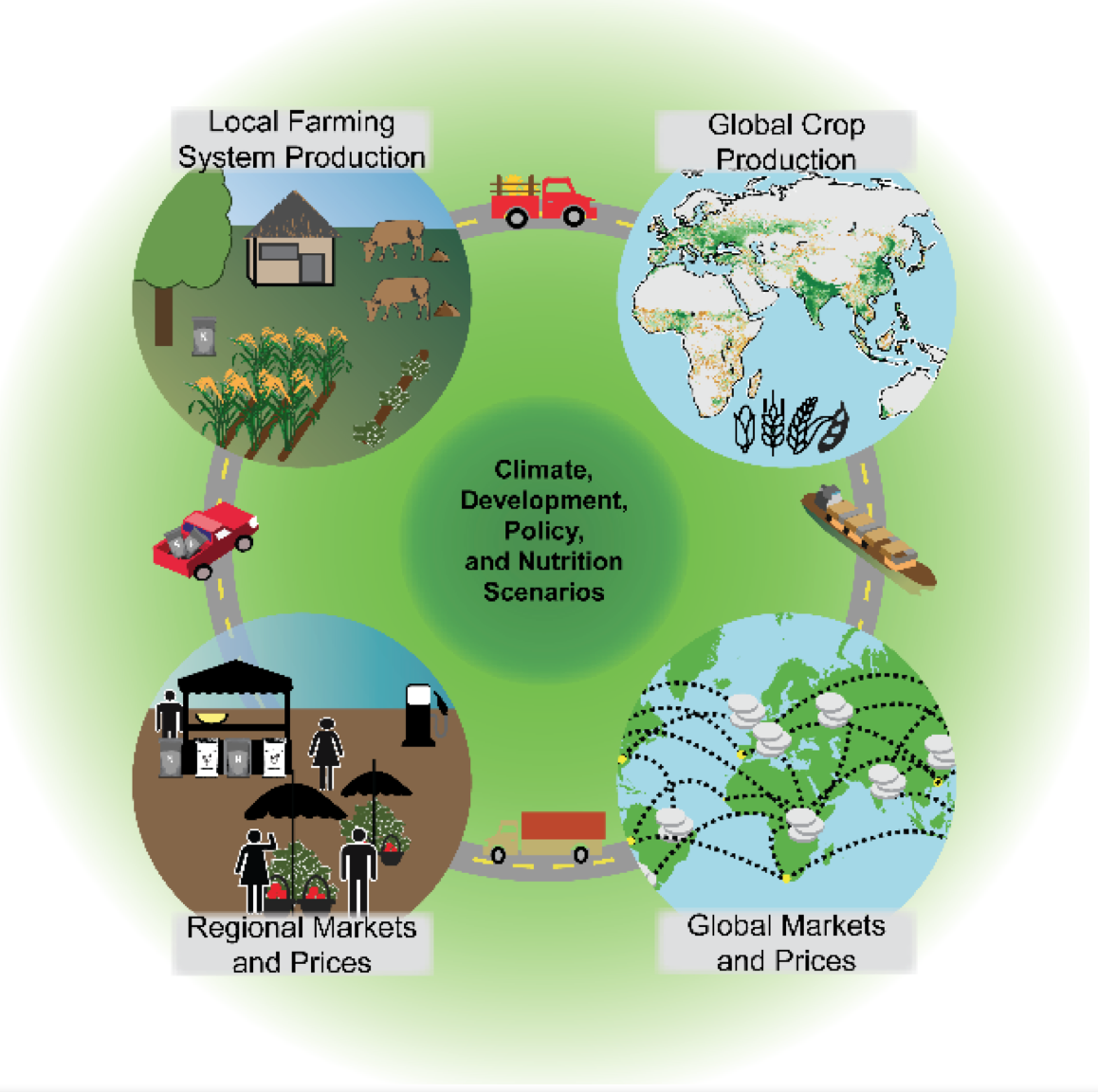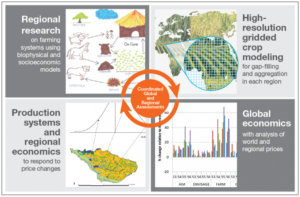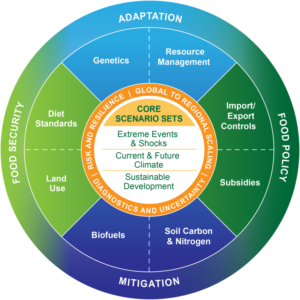Coordinated Global and Regional Assessments (CGRA)
Main Contacts for Initiative
Alex Ruine and Cynthia Rosenzweig
Brief Description of Activity
TheAgMIPCoordinated Global and Regional Assessments (CGRA) links AgMIPinitiatives across multiple disciplines, scales, and models in order to evaluate challenges more comprehensively. CGRA thus acts as a framework for large-scale assessments and the development of integrated systems to examine feedback loops and unintended consequences that might be overlooked in more narrow assessments.
Overview of Participants
Global Economics and GGCMI modelers; Regional Integrated Assessment crop and economics modelers; Food security and human nutrition experts
Current Research Focus
What model components and developments are needed to better simulate and assess climate shocks and their human impacts. Applications include multi-breadbasket failures, forecasting, and disaster risk mapping.
Recent Noteworthy Findings
A pilot CGRA study evaluated agricultural challenges of +1.5 and +2.0 C Global Warming scenarios to inform the upcoming IPCC Special Report. Findings indicated small global impacts from warmer conditions, but larger impacts (both positive and negative) at a regional level and large uncertainty related to CO2. Efforts to mitigate through carbon prices and bioenergy production had larger effects on global markets, however some farmers could benefit from related subsidies.

Figure. Overview of agricultural system linkages across scales and disciplines. These processes motivate the core building blocks of the AgMIP CGRA, which is supported by common scenarios and consistent passing of model outputs in order to track secondary consequences of impacts, policy changes, adaptation, and mitigation.
Recent Papers/Reports
7 papers submitted in time for IPCC 1.5 Special Report deadlines, including: Overview of results, CGRA framework, Climate, Global & Regional Econ, W. Africa
Prior Updates

Figure 1: Coordinated Global and Regional Assessments connect biophysical and socioeconomic models at local and global scales such that biophysical impacts across a distribution of farming systems have the potential to affect global markets, which in turn drive priorities of investment and management for farmers. These interactions are moderated by policies, climate, and food system infrastructure and actors.
The Agricultural Model Intercomparison and Improvement Project (AgMIP) is organizing Coordinated Global and Regional Assessments (CGRA) of climate impacts on agriculture and food security. The CGRA utilizes the networks and findings of AgMIP’s 30+ activities to construct a multi-model, multi-scale, multi-disciplinary, and multi-method framework capable of exploring major questions related to adaptation, mitigation, food policy, and food security in the face of an uncertain future. Changes in climate, socioeconomic development, farm management, agricultural technologies, and food demand will have direct and unforeseen consequences on the agricultural sector and those whose livelihoods are related to food systems, requiring a community effort utilizing cutting-edge science and information technologies. Addressing these major societal challenges requires careful collaboration and coordination to ensure that models connect efficiently and that assumptions and scenarios are consistent across the many models, disciplines, and scales involved (Figure 1).
The AgMIP CGRA was launched at a workshop of the Aspen Global Change Institute in Colorado in September, 2015. AgMIP leaders and major stakeholders addressed three major development priorities:
- Building a framework that efficiently connects biophysical (crop and livestock) and socioeconomic models at local to global scales.
- Connecting nutrition and food security into the modeling framework with interactions in both the biophysical and socioeconomic models.
- Designing scenarios that elucidate the implications and unforeseen consequences of mitigation, adaptation, food policy, and food security strategies. (Figure 2)
CGRA Site Survey

Figure 2: CGRA
An important step in conducting the AgMIP CGRA is the identification of existing expertise and modeling sites within the agricultural modeling community (of AgMIP and beyond). Plans for the CGRA include the coordination of simulations across participatory networks of crop and livestock modeling sites organized by region and/or species (similar to the network of 60 sites currently modeled by 30+ wheat modeling groups within the AgMIP Wheat Team). This will help ensure that we include key agricultural regions, important farming systems, and a diversity of models. These networks will also provide points for multi-model and multi-method comparison within the CGRA across spatial scales (point-based and global models) and major disciplines (biophysical, socioeconomic, and nutrition). To register your agricultural modeling site or grid, please visit the CGRA Site Survey. We encourage those interested in participation to also sign up for the AgMIP List-serv to receive the latest information on CGRA.
+1.5 °C Protocols
An initial activity of the AgMIP CGRA will be an investigation of the required mitigation pathways and likely impacts of efforts to limit the equilibrium global mean surface temperature increase to 1.5 °C above pre-industrial (late-1800s) conditions designed to inform the anticipated Intergovernmental Panel on Climate Change (IPCC) Special Report on the implications of a +1.5 °C World. Given the envisioned potential contribution of agricultural sciences to these reports, AgMIP is mobilizing its global network of researchers to contribute to the information base for this report through coordinated simulations and analyses. AgMIP is particularly suited to provide unique value through:
- Assessment of the +1.5 °C world across a network of site-based crop and livestock modeling sites, adding enhanced analysis of regional and crop-specific impacts.
- Analysis of agricultural sector outcomes under unique storylines of mitigation, land-use, climate-smart management, and diet standards in the form of Representative Agricultural Pathways (RAPs) that are consistent with a +1.5 °C world for crop and economic systems across scales.
- Utilization of transient simulations and sensitivity test simulation methodologies to envision future climate impacts on agricultural production.
- Examination of potential greenhouse gas mitigation over agricultural lands via carbon balance modeling.
A preliminary draft of the AgMIP CGRA +1.5 °C Guiding Protocols is now available and we encourage public comment sent via email to cgra@agmip.org.
